Interior Doors
Repairing and Replacing Pocket Door Track
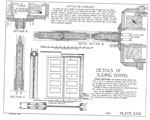
Replacing pocket door track is a repair that has some big problems associated with it. Are there replacement kits for pocket door hardware? Yes there are, see the article 'Pocket Door Hardware Kits' for more information.
Getting a kit is not the problem. Being able to install all the components of the kit is the problem.
Make sure that you can not get the door working before you pursue this option. See the article 'Lubricating Pocket Door Rollers' before proceeding. It is rare that a pocket door track would fail. See 'Tightening Pocket Door Track' for information on the one possible failure.
A 'Pocket Door Track' has (3) likely repair issues and (1) difficult choice. If you see your problem here, you can take a quick jump. Otherwise, read the overview below to zero in on your problem.
'Tightening Loose Track' - Since the track supports the weight of the door, tightening them would be a good idea. 'Lubricating Pocket Door Rollers' - The rollers ride inside the track. Sticking, frozen or noisy rollers can be a problem that is fixed quickly.
'Replacing the Rollers' - Find out the issues with matching the rollers to the track. 'Replacing the Track' - This is mostly a list of reasons why you don't want to try and do this. Find out what the issues are.
The pocket door track is found above the door, concealed in the jamb. The track spans the door opening and continues on into the cavity that is created by the pocket door frame. The door slides back and forth along the track. In fact, it disappears neatly into the wall, out of the way.
The pocket door track is sturdy enough to carry the weight of the door. The track can be different, depending on the manufacturer. The main thing to keep in mind is that the rollers are matched to the track. The track has grooves for the rollers to ride along. The weight of the door rests on these grooves via the rollers and hangers.
The track itself does not have any moving parts. Therefore it is fairly sturdy and rarely needs any attention or repairs. The exception to this rule would be when the track is not installed properly. The track needs to be installed securely to the door head. A track that loosens up will need to be tightened up.
What Can You Save? - There is not a lot that can go wrong with the track itself. When it works loose it needs to be tightened. This could run $50 to $75. When the rollers seize up you need to replace the track and the rollers at the same time. This could run $100 to $200.
How Hard Could It Be? - Tightening a loose track is not too difficult for the exposed portion. The hidden section is another story. Replacing a pocket door track is a fair amount of work. It may involve cutting out some drywall to get at the concealed end of the track.
Check the Simple Things! - Try lubricating the rollers before you do anything else, this is the solution most of the time.
What Can Go Wrong? - Replacing the track may involve cutting out some drywall to allow you to get at the screws. Patching drywall is a messy job and you have to paint the wall after your done. This is after you have removed the door and set it aside. This will be more than an afternoon job.
Pocket Door Track - How It Works
The pocket door track is usually an aluminum extrusion. They can be "C", "T", "F" shaped depending on the age of the door and the manufacturer. The important thing to remember is that, the rollers have to match the track.
The rollers run along grooves in the track, allowing the door to slide back and forth. This is what gives you that feature of the door 'dissappearing into the wall'.
The pocket door track is usually installed during the construction phase. When the walls are open, fastening the track is no problem. After the drywall is installed, access to the narrow 'pocket' is severely restricted.
The track is cut short of the door frame to allow for the removal of the pocket door rollers. The track is generally installed with wood screws that go into the head portion of the frame.
Tightening Loose Track
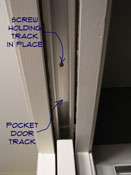
The pocket door track is attached to the head of the frame with screws. The problem with this is that the track is twice as long the door opening. Half of the track is hidden inside the pocket. Making the screws difficult to get to and even harder to tighten.
The first thing to try is to tighten the screws you can get to. Move the door all the way into the pocket and you will be able to see the track. Most pocket door tracks are held in place by five screws. You should be able to get to three of them from the open doorway. See if this tightens the track up sufficiently.
Cutting a hole in the drywall is an option, if you have to get at the concealed screws. Cut a twelve inch long by six inch high hole in the approximate center of the pocket. Cut the hole three or four inches below the top of the door. Try to save the piece of drywall for the patch later. For information on installing a drywall patch, see the article 'Repairing Drywall Holes'. This article has some instructions on how to cut out the patch and repair it afterward.
With the hole cut in the drywall you should be able to get at the screws to tighten them. Move the door out into the opening before you attempt this. You may need a flashlight to see the screws. Make sure the pocket door track is secure before you close up the hole in the drywall. Patch the drywall and paint the wall. That sure is a lot of work to tighten a couple of screws.
WARNING!! A pocket door can be heavy and awkward to handle. Get Help Before Attempting to Remove It!!! WARNING!!!
Replacing Pocket Door Track
 If you can get to it, replacing pocket door track is simple. A few screws and that's it.
If you can get to it, replacing pocket door track is simple. A few screws and that's it.
Generally, the length of the track is set by the door size. A 2' 6" door will have have a track that is approximately 58 1/2" long. The length of the track is determined by doubling the door size and then subtracting a relief space of around 1 1/4" to 1 1/2".
The relief space is to get the rollers in and out, once the framework is installed. The track is installed tight to the inside end of the pocket and the relief space is left at the open, strike side jamb.
The track is usually cut to length when you buy the kit. Again, the kits are sized by the size of the door. See the article 'Pocket Door Hardware Kits' for more information on what's available.
Accessing a Pocket Door Track
You do not need to take the door completely apart. You do need to be able to get at the top sixteen inches of the pocket to access the screws.
There is some good news. You only need to get at one side or the other. The bad news is that this will involve cutting out some drywall. The drywall will need to be patched, taped, mudded and painted.
Are you sure you want to do this?
Cutting Out the Drywall
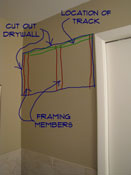 You need a 16" x the Width of Door opening to access the back half of the track. See the articles in the segment on 'Drywall Patching', especially the article on 'Repairing Big Holes in Drywall', for more information. After the patch is installed, you will want to see the article 'Taping and Mudding Drywall' for tips on how to finish the wall.
You need a 16" x the Width of Door opening to access the back half of the track. See the articles in the segment on 'Drywall Patching', especially the article on 'Repairing Big Holes in Drywall', for more information. After the patch is installed, you will want to see the article 'Taping and Mudding Drywall' for tips on how to finish the wall.
Once you have cut out the drywall, you should be able to see the track and get at the screws.
Removing the Track
Now that you can get at it, removing the track is easy. Use a battery drill and bit holder or a screwdriver to remove the screws.
Have someone hold the track before you remove the last couple of screws. No need to damage the floor by letting the track fall down.
Installing a New Pocket Door Track
The track should be already cut to right length for your door size. It should be slightly shorter than the overall length of your header (approximately 1 1/4" to 1 1/2" shorter). Remember, the relief to install the rollers is at the end by the door strike. The track should go tight to the frame at the inside of the pocket.
The track should have holes at the proper locations for the screws. Just follow that pattern.
Align the track in the center of the header. Keep it parallel the entire length of the header. The track needs to be installed with the 'relief area' at the strike side of the door frame. This allows for the installation of the pocket door rollers.
Summary
Did dealing with your pocket door track turn out to be a big problem? That is certainly not good news. The track is durable and normally problem free. Poor installation may have been the reason you had a problem. A lazy carpenter could be to blame.
Seized up rollers would be the other troublesome situation. A lack of maintenance would cause the rollers to tighten and eventually quit working. Maybe you where able to free them up with some oil. What a relief that was. Were you able to find replacement rollers? Or did you have to buy a whole kit. Hope everything turned out well, now for another repair task.
Troubleshooting Pocket Doors
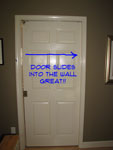 Pocket doors are in their glory when space is tight. Bathrooms, dressing areas, hallways and closets are all candidates for using a pocket door. The key advantage is that the door slides into the wall, out of the way.
Pocket doors are in their glory when space is tight. Bathrooms, dressing areas, hallways and closets are all candidates for using a pocket door. The key advantage is that the door slides into the wall, out of the way.
This leaves the floor area on either side of the wall for other things. No need to worry about leaving an area for the door to swing in. Architects and builders will often use this type of door in locations where space is critical and the swing of a door will interfere with something else.
Do you have another door problem or type of door? See the article on 'Fixing Doors In Your Home' for more information.
How Pocket Doors Are Different
Pocket doors pose special repair problems. They operate differently than the rest of the doors in your home. Standard doors have hinges that are attached to the door frame. A door that slides into a pocket has hangers that are attached to the top of the door. The hangers are in turn attached to rollers that allow the door to slide.
Most of the repair issues will be related to the hangers or the rollers. Rollers as the have small wheels that can tighten up or even seize up, making the door hard and sometimes impossible to move. The hangers affect the alignment of the door. Gaps along the sides or latches that won't work can be traced back to the hangers.
Pocket doors are usually installed during the construction of the home. They have a special frame that has to be built into the wall. The header for a pocket door has to be twice as wide as a normal door. The reason for this is that half of the door opening is hidden in the wall.
The electrical, plumbing and heating utilities have to be routed around the pocket. Since the door has to slide into the cavity, there is no room for other things. It is possible to have a switch next to a pocket door, however, a special shallow box has to be used.
For the above reasons, pocket doors are difficult to add at a later date. A considerable amount of demolitions is involved in getting them installed.
Repairing Pocket Doors – Finding Help
Pocket door repairs are mostly simple and require only a few minutes. Adjusting the door and lubricating it are two common items. Putting the door back onto the hangers is also a common task. Why call a repairman every time you have an issue? You can take care of most things yourself and save some money.
Below you will find some common problems. There is a brief description and a link that will lead you to additional information. Our evaluation sections of the pages will help you to decide if you want to make the repair. The "What Can You Save?" and "How Hard Could It Be?" sections give you a quick overview of the repair. This will help you decide if it is using Common Sense to make the repair yourself.
The "Check the Simple Things First" section will clue you in to easy fixes to check for. Many times something easy will eliminate a problem without the aggravation of an involved repair. In an effort to warn you about what you are in for, there is the "What Can Go Wrong" section. Forewarned is forearmed as they say. Knowing what to watch out for is always helpful.
Troubleshooting Pocket Doors
This page provides a general discussion on pocket door repair issues. Information on adjusting the door is provided along with an explanation of how the adjustments affect the door. Problems with gaps along the edge of the door and latches that don't work are related to the adjustment.
Lubrication is an important maintenance item for this type of door. Find out how and when to provide lubrication.
Pocket Door Rollers
The rollers are the moving parts for a pocket door. Most doors have two roller assemblies with three or four nylon wheels on each one. Stiff or frozen rollers can make the door difficult to move. Follow this link for information on the rollers.
Pocket Door Hangers
The hangers are a threaded bolt with special ends that allow a bracket to slide onto them. The bracket is attached to the door. With a special wrench you can adjust the hanger. These adjustments move the door up and down and change the margins on the side. This link will take you to an article that discusses this topic.
Pocket Door Track
The pocket door track provides the guide for the pocket door to follow. The track is specially shaped to allow for the rollers. The track extends into the pocket and is hidden from site.
Pocket Door Guides
The guides help the door to align properly when it gets near the latch. Without the guides it is difficult to get the door to go into the stops. When this happens you cannot get the latch to work.
The guides are simple and easy to replace and do not cost very much.
Pocket Door Locks and Latches
Pocket doors need to have a way of maintaining privacy. However, the fact that they slide back into the wall makes a conventional door knob useless. Special latches have been designed to work with pocket doors.
These locks have special problems and look completely different.
Removing a Pocket Door
Pocket doors do not have hinges and so taking one off, differs from a regular door. There is a trick to removing them this article will provide the steps needed to successfully take down a pocket door.
Replacing a Pocket Door
When a pocket door is taken off or it gets knocked off its track, it can be difficult to put back in place. Again there is a method that needs to be followed to get the pocket door back on the track.
Pocket Door Summary
Troubleshooting and repairing issues with pocket doors is a simple task most of the time. Replacing the track can be a big job that may even require some drywall patching. Most of the time it is just some adjusting and lubricating. A few minutes work and your door will be quiet and smooth.
Now that you have addressed your disappearing door problems, you are ready to move onto other home repairs. Do you have a list? Or is it a job jar? Whatever your tracking method, you can go to the next item. Unless you have earned a break.
Pocket Door Rollers
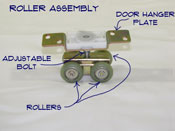 There are (3) Key Topics associated with 'Pocket Door Rollers', take a quick jump here or check out the overview below:
There are (3) Key Topics associated with 'Pocket Door Rollers', take a quick jump here or check out the overview below:
Lubricating Pocket Door Rollers - This is your likely choice for getting them to work better. Noisy and sticking rollers will respond to lubrication.
Removing Pocket Door Rollers - It is not that hard to take them out, but it involves taking the door off. Removing them will make sense if they are seized up.
Replacing Pocket Door Rollers - There are some issues with this idea. It can be done, but you want to know the facts first.
For a general discussion on 'Pocket Door Repair', go to this page. You will find information on adjusting, lubricating and repairing pocket doors. Most of the time it is a simple job that only takes a few minutes.
What Can You Save? - It would easily be $75 to $125 for someone to come out. They would likely lubricate and adjust the door, normally it would take ten or fifteen minutes.
How Hard Can It Be? - Lubricating pocket door rollers is a simple task. Removing and replacing them is more work and not likely to be needed.
What Can Go Wrong? - Do not attempt to replace the pocket door rollers unless you know they match the track you have. Don't get oil everywhere when you lubricate them.
How Pocket Door Rollers Work
Pocket door rollers keep the door running inside of a metal track. The rollers are made of metal and nylon and usually have three or four rollers on each assembly. Regular doors are supported by hinges. The hinges are attached to the side of the door. A pocket door has hangers that are attached to the top of the door with metal brackets. Like any wheel that uses bearings, lack of lubrication can cause them to wear out and start to tighten. When this happens the door becomes hard, sometimes impossible, to move.
The door rollers need to be able to ride in the grooves in the track. The track is 'C' shaped with the sides curled up to form a groove. The style of roller usually matches the metal track that they ride in. Finding rollers that are an exact match for the ones that you have may be challenging. You can buy kits that have new track included. The problem is that unfastening and installing the track inside the pocket is pretty hard.
Pocket Door Rollers – Conclusion
This article provided you with an overview of the issues associated with pocket door rollers. With the information provided you should be able to take care of your problem without too much trouble. Still have issues or questions?
Pocket Door Hangers
Pocket door hangers, unlike hinges, support the door from the top. A standard swinging door has hinges along the side that support it, usually three, sometimes two. A pocket door has two hangers attached to the top of the door. The hangers are also connected to the rollers. The rollers run in the track over the door allowing the door to slide back and forth.
The hangers are really more like a bolt. This is a special bolt that has a head on it the fits into a bracket on the door. The head of the bolt can slide in and out of the bracket, so that the door can be removed. The other end of the bolt is threaded into the roller assembly. The hanger and bracket are designed in a way that allows for adjustment.
Are you having trouble with the pocket door hangers? See the article 'Troubleshooting Pocket Doors'. You will find information on adjusting, lubricating and repairing pocket doors. Most of the time it is a simple job that only takes a few minutes.
Adjusting Pocket Door Hangers
The end of the door hanger that fits into the bracket has a section that is hex shaped. This allows for a wrench to be used as an adjustment. Easy, right, just get a wrench and away you go. The problem is that the area above the door is pretty narrow. You usually don't have room for a regular wrench.
The hardware kit that comes with the pocket door comes with a thin wrench that is used for adjustment. If you are one of those highly organized people that has a system for keeping things like this, you can probably just go get it. For the rest of us, it might be a problem to find it. If your pocket door was installed by the builder of the house, you may never have had the wrench in your possession.
To adjust the door hangers you will have to get a thin profile wrench of the proper size for the adjusting nut on the hanger. You may be able to find one at a home supply store or you can search online for one.
Adjusting the pocket door hangers is pretty simple after you have a wrench that will fit. Tightening the hangers will raise the door. The opposite is also true, loosening the hangers will lower the door. The tricky part is that an adjustment to the hangers on the top of the door also affects the sides of the door.
For a complete discussion on how to adjust a pocket door, see the article 'Pocket Door Adjustment'. This article provides pictures and detailed instructions on how to adjust a pocket door along with other pocket door repair information.
Putting a Pocket Door Back On
Pocket doors can come of the hangers and be difficult to move. It is fairly simple to put them back on. There is a retention clip on the bracket. First you need to open the clip with a screwdriver or flat object like a 'butter knife'. Yes I said butter knife, its amazing how many things you can fix with a butter knife. Align the pocket door hanger with the bracket on the top of the door.
Carefully lift the door and slide the hanger into the slot on the bracket. Once the door is in place you can slide the retention clip back into place. Check the door and make sure it is running on the track correctly. It is a little more trouble when the door comes off the back hanger. See the articles 'Putting a Pocket Door Back On' for detailed information.
Pocket Door Hangers Summary
Pocket door hangers are simple yet important for the operation of a pocket door. You use them to adjust the door and keep it working smoothly. The hangers fit into a bracket at the top of the door and thread into the rollers.
The main purpose of the hanger is for adjustment. The adjustments are fairly sensitive and may require a little patience. After a little experimenting you should get the idea of how to adjust them. Lining up the latch set and fixing gaps are all accomplished by adjusting the pocket door hangers.
Lubricating Bifold Closet Door Hardware
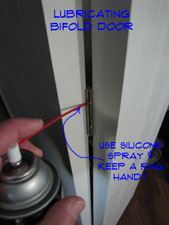 Lubricating bifold doors is the solution when things are sticking or making noise. Just like other door hardware the hinges can start to squeak. A little oil can do a lot of good on a troublesome door.
Lubricating bifold doors is the solution when things are sticking or making noise. Just like other door hardware the hinges can start to squeak. A little oil can do a lot of good on a troublesome door.
The hinges, rollers and pivot pins are the moving parts. Use a good quality silicone lubricant. Keep a rag handy and don't over do it. Work the door panels back and forth until the move freely and don't make noise. Watch for drips and clean them up with the rag. Lubricating bifold doors move is not rocket science and you should be able to focus on the spots that are causing problems.
You may need to work the door back and forth a few times after you oil it. Keep a rag handy for the oil that oozes out. While you are at it, check all the moving parts on the door. Add some oil gingerly and you won't have to do this again for a while. That's all there is to lubricating bifold doors.


